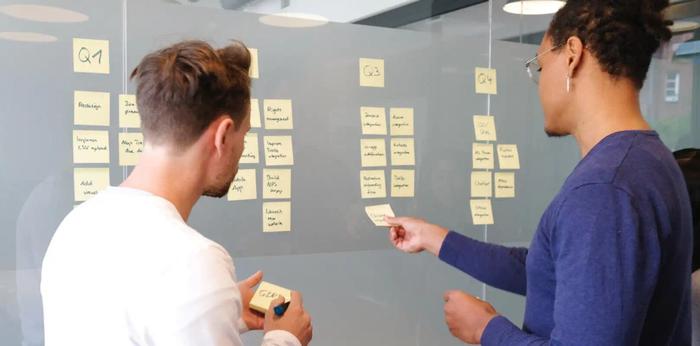Good project management is an essential skill that every business needs. It’s a way of keeping your organization aligned and on track when working on a new project.
Project planning and management needs a well-organized plan that covers everything from budget, milestones and communication procedures.
70% of business projects fail, often due to poor planning and management. This is why many businesses invest in project managers to keep track of project execution.
Yet only 22% of organizations use tools like CRMs or project management software to track customer relations during this time.
In this blog post, we’ll discuss what project management is, why it’s important, and the steps you need to take to effectively manage a project in your own business.
What is project management?

Project management is the process of planning and organizing a company’s resources to complete or manage a specific task. It requires utilizing specific skills, tools, knowledge, and techniques to deliver an end product.
This can be anything of value, like a piece of software, a construction project, or the expansion of an internal department.
Project management is often associated with particular industries like construction, engineering, and IT. The process is roughly the same no matter the business or industry.
It’s simply a way to keep an organization aligned towards an end goal.
Three types of project management methodologies
Every project is different. Some may need a large budget and take years to complete, others may take only a few days or weeks.
There are many methodologies that businesses could consider. However, most organizations use one of the below three project management models when planning a large-scale project. These are:
- Waterfall
- Agile
- Lean
Let’s explore the specifics of these project management models in more detail.
Waterfall model
This is considered the most traditional of the three models. It has a chronological structure and requires each step to be fully completed before moving on to the next.
This linear structure means that progress flows in one direction - hence the name ‘waterfall’. This model requires attention to detail in your sequences and timelines as a new task cannot be started until the one before it is completed.
With this model, the size of the team will grow over time. This is because smaller, simplier tasks are usually completed first followed by larger more complex projects.
Agile model
Unlike the waterfall model, an agile model doesn’t follow a sequential order. Instead of taking a stage-by-stage approach, tasks are completed in parallel to one another.
For example, you may have a sales team working on an account pitch, while your customer support team explores ways to solve client queries.
This approach can help businesses complete projects quickly and efficiently. It can also help you identify errors in your approach without having to go back to an early stage of your project.
Lean model
This model focuses on avoiding waste, saving both time and resources. The main concept is to create more value for customers with a smaller budget and team.
It means that only essential resources are permitted. Anything else is considered wasteful. This model works best for small projects and businesses that need to prioritize resources.
What is a project plan?
A project plan is a blueprint that covers the goals, objectives, and tasks your team needs to complete to accomplish a project. It should include a range of specifics such as:
- Your project schedule
- Project scope
- Due dates
- Deliverables
- Specific project stages.
A well-structured project plan helps your team understand exactly what is expected of them. That way there is no confusion and your team can focus on their specific tasks, maximizing productivity.
What is a project manager?
Projects are typically led by an appointed project manager. They're responsible for a range of aspects including the day-to-day operations of their team. Put simply, they are in charge of the project and its outcome.
This person is reponsible for managing the six main aspects of a project. These are:
- Scope: This refers to the totality of the outputs, outcomes, benefits, and the work required to achieve your end project goal.
- Schedule: How long will the project take and when do you expect certain tasks to be completed?
- Budget: They’re responsible for staying within a set budget and accurately forecasting how much the project will cost.
- Risk: Any risks associated with implementing the project as well as potential challenges that could result from failing to complete the project.
- Quality: A project manager is responsible for the overall quality of the end deliverable as well as the standard of work that’s gone into the project.
- Resources: Project managers need to optimize both labor and non-labor resources.
What skills do project managers need?
Project managers need a range of skills to be successful. And in a digital-first world, finding the right skills is more important than ever.
To be successful project managers need to:
- Be capable of leading remote and hybrid teams
- Hold themselves accountable
- Actively listen to their team
- Think critically
- Ask the right questions
- Manage change, interpersonal relationships, and conflicts.
This is just a brief overview of the skills needed but it highlights how important it is for project managers to be resourceful and adaptable.
Why is project management important?

Project management is crucial in helping organizations run smoothly, efficiently, and effectively. Without it, businesses struggle to drive change and successfully implement new practices, services, and products.
When done right, project management enables leadership teams to plan and manage projects. It ensures that every objective and deliverable is completed on time and within budget.
It can also support better communication and collaboration between teams, provide data-driven insight, and help you make better business decisions.
It is no wonder that the demand for project managers is growing rapidly. By 2027, employers will need 87.7 million professionals working in project management, but the same study found a growing talent gap could lead to a loss of 207.9 billion in global GDP.
What are the three Cs of project management?
To manage a project effectively, you need to be adaptable. The business landscape is ever-changing, so when facing a challenge it’s important to consider the three Cs of project management: culture, clarity, and course correction.
These three principles are essential for any successful project. Let’s explore how they work and their importance in more detail.
Culture
Creating a strong team culture is an essential part of project management. This is because well-aligned project teams perform better than those that aren’t aligned.

It’s important to intentionally create an environment of communication and trust. A project manager needs to ensure that every team member is heard and actively engaged with the task they’ve been assigned.
That way they can get the best results out of everybody.
Clarity
Clarity is a crucial element of project management. A team can only be successful when each member knows their role. Project managers need to ensure that every task is clearly identified, assigned appropriately and briefed in full. Creating and selling a vision that both the client and team share is essential to success. Without it, project outcomes may be unclear leading to missed deadlines and poor work output.
Course correction
Despite our best efforts and meticulous planning, projects don’t always go as planned. Project management requires staff to proactively spot problems and redirect efforts as needed.
You may have your project planned up to the most minute details, but a sudden change in budget, workload, or workforce could cause problems.
Having a plan of action for when things go wrong is essential. It saves you time and effort while keeping you on the right track
How to manage a project
Managing a project is no walk in the park. You gave a lot of elements to consider, which is why so many businesses choose a platform that integrates CRM with project management. This allows you to handle both aspects seamlessly without switching between platforms.

Capsule’s CRM allows you to streamline your sales and service operations with Projects - our built-in project management tool. To learn more about how the platform works take a look at our 12 ingenious ways you can utilize the project management software in your business
There are seven steps to consider when creating a project management plan. It’s essentially the bones of your plan and allows you to track and manage the progression of any tasks as it develops.
These steps are as follows:
- Defining goals and objectives
- Setting success metrics
- Clarifying roles and stakeholders
- Setting a budget
- Determine how to measure progress
- Create a workflow roadmap
- Presenting a final plan
Let’s examine these steps in detail and identify how you can implement them in your own plan.
Step one: Define your goals and objectives
Every project has an end goal. It’s something that you and your team are working towards and want to achieve. It helps staff to stay motivated and focused while keeping them aligned with your company's objectives.
Employees who feel their work aligns with a company goal are twice as motivated as those who don’t. However, only 26% of employees understand how their individual role contributes to the wider organizational goal.
Making your objectives clear is a great way to boost motivation. It helps employees stay focused and push harder to achieve their shared goals.
Step two: Set success metrics
Once you’ve defined your goals, you need to find a way to quantify them. Setting key measurable success metrics is a way to prove that your work is having the right impact.
You can do this by setting what are commonly referred to as SMART goals. SMART stands for specific, measurable, achievable, relevant, and time-bound and they help you to easily assess your achievements.
For example, if you’re organizing an event, you may set a goal to have 100 people buy tickets within the first week of them being on sale.
If you sell more than 100 tickets then you know that you have exceeded your goal. If you sell less than 100 then you know you need to work on changing your current tactics.
Step three: Clarify stakeholders and roles
Working on a project is a team effort. It requires an organized group of workers, to pool their skills and efforts to achieve a common goal. So, it’s important to ensure that everyone knows what’s expected of them.
As part of your project management plan, you should assign roles and responsibilities and define any objectives set by key stakeholders. You should outline any specifics around hierarchy, including who has the final say on financial or creative aspects.
It’s important to document these decisions. Having written proof of who is responsible for certain aspects can prove crucial later on should you face problems with deadlines or work distribution.
Step four: Set a budget
Projects can be costly, even the small ones. Whether you need new materials, software, or freelancers, costs rapidly add up.
Once you’ve established your goals, you need to set a budget. This should be done before you begin any work on the project.
Imposing financial limits helps with resource management as you’ll be able to manage expectations, track progress, and make smart economic decisions.
Planning your budget and how it will be allocated can help you avoid any nasty surprises in the future. It'll give you an idea of exactly how much each stage will cost, so you can adjust your strategy accordingly.
Step five: Determine ways to measure progress
Tracking a project's progress is crucial to measuring success. One of the best ways to do this is by setting milestones, deliverables, and project dependencies.
Setting milestones helps you visualize how a project is progressing. They don’t necessarily need to be dated, but hitting one marks an accomplishment in your project.
Something quantifiable that can be shared with relevant stakeholders.
Deliverables are something produced or provided as a result of project success. They’re usually deliverones once you reach a milestone - this could be a prototype of a product or a return on investment. They're a way to show exactly how far the project has progressed and whether the results are aligned with what was first expected.
Project dependencies are tasks that can’t be started until others are finished. This is another way to track progress and ensure that work only starts once other parts of the project are ready.
Step six: Create a workflow roadmap
To meet business goals you should clearly plan your project timeline. This ensures clarity across the business and helps you to make better strategic decisions to meet goals.
Not all projects will have clearly defined timelines, i.e. ones with specific calendar dates. Some elements may take longer than expected or require more work to complete.
In this instance, you may opt for a project roadmap. This can help you clarify the order of operations without having to establish exact dates,
Creating a timeline is a useful way to break the process down into manageable smaller tasks. This helps to ensure that no steps are missed and everything happens as and when it’s needed.
Step seven: Create a communication plan
Communication is incredibly important when working on a project. Your team needs to be aware of any updates as and when they happen. This way work isn’t repeated and mistakes aren’t made.

You may have people working remotely, as well as external and internal stakeholders who require regular updates. With so many different schedules to work around, it’s best to come up with a plan. You might want to send out weekly internal updates or hold monthly status reports with clients and high-level board members.
Consistent communication is key, so determine the best method for your organization.
Conclusion
Project management is no easy task. It requires an agile mind, expert planning, a trusted team and the right tools. Before beginning any project, businesses mustconsider how this process will affect their customers and clients.
Tracking customer interactions can be tricky at the best of times, especially when you need to keep your eyes on multiple moving parts. Simplify your customer interactions with Capsule.
Click here to learn more about Capsule CRM and access a 14-day free trial.




